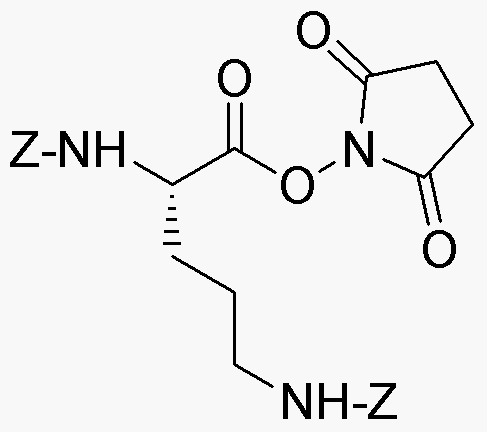Na,d-Bis-Z-L-ornithine N-hydroxysuccinimide ester is widely utilized in research focused on:
- Peptide Synthesis: This compound serves as a valuable building block in the synthesis of peptides, particularly in the development of therapeutic agents. Its unique structure enhances the stability and bioactivity of the resulting peptides.
- Drug Development: In pharmaceutical research, it is used to create prodrugs that improve the solubility and absorption of active pharmaceutical ingredients, leading to more effective treatments.
- Bioconjugation: The compound is employed in bioconjugation techniques, allowing researchers to attach biomolecules to drugs or imaging agents, which can enhance targeting and efficacy in cancer therapies.
- Protein Modification: It is utilized for modifying proteins to study their function and interactions, aiding in the understanding of various biological processes and disease mechanisms.
- Research in Neuroscience: This chemical plays a role in studies related to neurotransmitter systems, potentially leading to advancements in treatments for neurological disorders.
Informations générales
Propriétés
Sécurité et réglementation
Applications
Na,d-Bis-Z-L-ornithine N-hydroxysuccinimide ester is widely utilized in research focused on:
- Peptide Synthesis: This compound serves as a valuable building block in the synthesis of peptides, particularly in the development of therapeutic agents. Its unique structure enhances the stability and bioactivity of the resulting peptides.
- Drug Development: In pharmaceutical research, it is used to create prodrugs that improve the solubility and absorption of active pharmaceutical ingredients, leading to more effective treatments.
- Bioconjugation: The compound is employed in bioconjugation techniques, allowing researchers to attach biomolecules to drugs or imaging agents, which can enhance targeting and efficacy in cancer therapies.
- Protein Modification: It is utilized for modifying proteins to study their function and interactions, aiding in the understanding of various biological processes and disease mechanisms.
- Research in Neuroscience: This chemical plays a role in studies related to neurotransmitter systems, potentially leading to advancements in treatments for neurological disorders.
Documents
Fiches de données de sécurité (FDS)
La FDS fournit des informations de sécurité complètes sur la manipulation, le stockage et l’élimination du produit.
Spécifications du produit (PS)
Le PS fournit une description complète des propriétés du produit, notamment sa composition chimique, son état physique, sa pureté et les exigences de stockage. Il détaille également les plages de qualité acceptables et les applications prévues du produit.
Certificats d'analyse (COA)
Recherchez des certificats d'analyse (COA) en saisissant le numéro de lot du produit. Les numéros de lot et de lot se trouvent sur l'étiquette d'un produit, après les mots « Lot » ou « Lot de fabrication ».
Numéro de catalogue
Numéro de lot/série
Certificats d'origine (COO)
Ce certificat d'exploitation confirme le pays dans lequel le produit a été fabriqué, et détaille également les matériaux et composants utilisés et s'il est issu de sources naturelles, synthétiques ou autres sources spécifiques. Ce certificat peut être requis pour les douanes, le commerce et la conformité réglementaire.
Numéro de catalogue
Numéro de lot/série
Fiches de données de sécurité (FDS)
La FDS fournit des informations de sécurité complètes sur la manipulation, le stockage et l’élimination du produit.
DownloadSpécifications du produit (PS)
Le PS fournit une description complète des propriétés du produit, notamment sa composition chimique, son état physique, sa pureté et les exigences de stockage. Il détaille également les plages de qualité acceptables et les applications prévues du produit.
DownloadCertificats d'analyse (COA)
Recherchez des certificats d'analyse (COA) en saisissant le numéro de lot du produit. Les numéros de lot et de lot se trouvent sur l'étiquette d'un produit, après les mots « Lot » ou « Lot de fabrication ».
Numéro de catalogue
Numéro de lot/série
Certificats d'origine (COO)
Ce certificat d'exploitation confirme le pays dans lequel le produit a été fabriqué, et détaille également les matériaux et composants utilisés et s'il est issu de sources naturelles, synthétiques ou autres sources spécifiques. Ce certificat peut être requis pour les douanes, le commerce et la conformité réglementaire.


